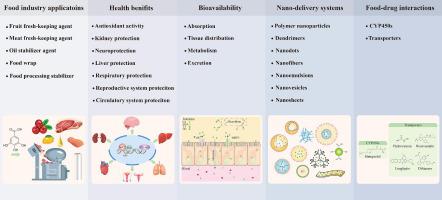Food Research International ( IF 7.0 ) Pub Date : 2024-01-29 , DOI: 10.1016/j.foodres.2024.114068 Zedong Xiang 1 , Huida Guan 1 , Xiang Zhao 1 , Qi Xie 1 , Zhejun Xie 1 , Fujie Cai 1 , Rui Dang 1 , Manlin Li 1 , Changhong Wang 1

|
Gallic acid (GA), a dietary phenolic acid with potent antioxidant activity, is widely distributed in edible plants. GA has been applied in the food industry as an antimicrobial agent, food fresh-keeping agent, oil stabilizer, active food wrap material, and food processing stabilizer. GA is a potential dietary supplement due to its health benefits on various functional disorders associated with oxidative stress, including renal, neurological, hepatic, pulmonary, reproductive, and cardiovascular diseases. GA is rapidly absorbed and metabolized after oral administration, resulting in low bioavailability, which is susceptible to various factors, such as intestinal microbiota, transporters, and metabolism of galloyl derivatives. GA exhibits a tendency to distribute primarily to the kidney, liver, heart, and brain. A total of 37 metabolites of GA has been identified, and decarboxylation and dihydroxylation in phase I metabolism and sulfation, glucuronidation, and methylation in phase Ⅱ metabolism are considered the main in vivo biotransformation pathways of GA. Different types of nanocarriers, such as polymeric nanoparticles, dendrimers, and nanodots, have been successfully developed to enhance the health-promoting function of GA by increasing bioavailability. GA may induce drug interactions with conventional drugs, such as hydroxyurea, linagliptin, and diltiazem, due to its inhibitory effects on metabolic enzymes, including cytochrome P450 3A4 and 2D6, and transporters, including P-glycoprotein, breast cancer resistance protein, and organic anion-transporting polypeptide 1B3. In conclusion, in-depth studies of GA on food industry applications, health benefits, bioavailability, nano-delivery systems, and drug interactions have laid the foundation for its comprehensive application as a food additive and dietary supplement.
中文翻译:

膳食没食子酸作为抗氧化剂:回顾其食品工业应用、健康益处、生物利用度、纳米递送系统和药物相互作用
没食子酸(GA)是一种具有有效抗氧化活性的膳食酚酸,广泛分布于食用植物中。 GA在食品工业中作为抗菌剂、食品保鲜剂、油脂稳定剂、活性食品包装材料、食品加工稳定剂等得到应用。 GA 是一种潜在的膳食补充剂,因为它对与氧化应激相关的各种功能性疾病有益,包括肾脏、神经、肝脏、肺、生殖和心血管疾病。 GA口服后吸收代谢迅速,生物利用度低,易受肠道菌群、转运蛋白、没食子酰衍生物代谢等多种因素影响。 GA 表现出主要分布到肾脏、肝脏、心脏和大脑的趋势。目前已鉴定出37种GA代谢物,其中I相代谢中的脱羧和二羟基化以及II相代谢中的硫酸化、葡萄糖醛酸化和甲基化被认为是GA在体内的主要生物转化途径。不同类型的纳米载体,如聚合物纳米颗粒、树枝状聚合物和纳米点,已被成功开发出来,通过提高生物利用度来增强 GA 的健康促进功能。由于 GA 对细胞色素 P450 3A4 和 2D6 等代谢酶以及 P-糖蛋白、乳腺癌抗性蛋白和有机阴离子等转运蛋白的抑制作用,可能会导致与羟基脲、利格列汀和地尔硫卓等常规药物发生药物相互作用。 -转运多肽1B3。 总之,对GA在食品工业应用、健康益处、生物利用度、纳米递送系统和药物相互作用方面的深入研究,为其作为食品添加剂和膳食补充剂的综合应用奠定了基础。






























 京公网安备 11010802027423号
京公网安备 11010802027423号